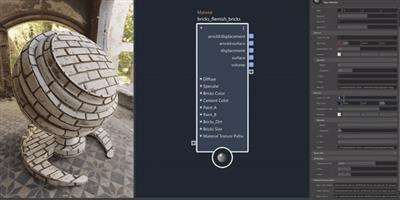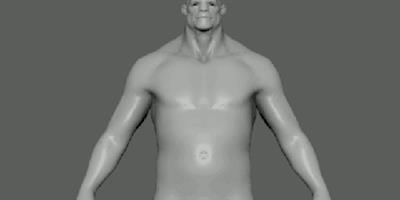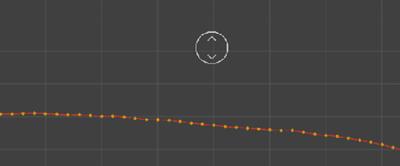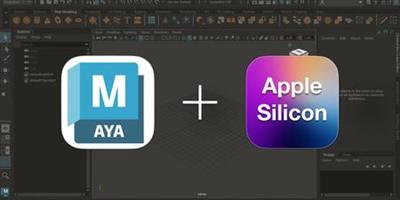Autodesk Maya 2024 Linux (x64)
- ПРОГРАММЫ
- 3-04-2023, 04:36
- 226
- 0
- voska89

Free Download Autodesk Maya 2024 Linux | 3.5 Gb
Languages Supported: English, 日本語, 简体中文
Autodesk has released Maya 2024, the latest version of its 3D modelling and animation software. The update comes with enhanced modeling workflows, new Graph Editor tools, animation performance upgrades, a redesigned Time Slider, and more.
Product:Autodesk Maya
Version:2024 *
Supported Architectures:x64
Website Home Page :www.autodesk.com
Languages Supported:multilanguage
System Requirements:Linux **
Size:3.5 Gb

It's a wide-ranging update, expanding the software's retopology toolset, adding a complete new USD-based material authoring system, and neat new brush-based workflows for 'sculpting' animation curves. The release also introduces native Apple Silicon support, with the core application, its Bifrost multiphysics plugin and the MtoA plugin for the Arnold renderer all running natively on Macs with M1 and M2 processors.

Retopology: updates to Retopologize and Quad Draw
Maya 2024 features a number of changes to the software's retoology toolset. New options in Retopologize, Maya's automated retopology system, include Retopologize with Symmetry, which generates even edge flow on both sides of a mesh, as shown in the image above. There are also new options for selectively preserving features in areas of detail on a mesh, including options for preserving edges according to their angle or component tags. Other changes include the option to scan the mesh for potential issues like non-manifold geometry before running Retopologize; and to retain the original input mesh in the scene afterwards. For manual retopology, Make Live now supports multiple objects, making it possible to use the Quad Draw tool to draw out new topology across the surface of groups of meshes.

3D modelling: new option to Unsmooth subdivided meshes and support for MikkTSpace
Modelers also get a new Unsmooth command to unsubdivide any Catmull-Clark-subdivided mesh, in order to create low-res versions of meshes that have been subdivided during digital sculpting. Other changes include support for the MikkTSpace standard for tangent space when baking normal maps, improved performance in the UV Editor, and new tool shelves for UV Editing, Curves and Surfaces tools. The release notes list updates to Boolean modelling, although the changes - including the option to duplicate Boolean input objects by right-clicking - were actually made in Maya 2023.1 last year.
Materials: new USD-based LookdevX toolset for look development
Look development artists get LookdevX, a new toolset for creating USD shading graphs in Maya. It enables artists working with data in the Universal Scene Description format to create custom materials and have Maya auto-save them to the active USD layer. Unlike materials created using the existing Hypershade editor, materials created using LookdevX can be used throughout an entire USD-based pipeline without conversion. According to Autodesk, the workflow is intended to ensure "consistent look development across products, platforms and game engines".

Animation: new tools to 'sculpt' animation curves, plus updates to the Graph Editor and Time Slider
Animators get a number of general improvements to Maya's Graph Editor, including a neat set of brush-based tools for 'sculpting' animation curves. The image above shows the Grab tool, but you can also Smooth or Smear animation curves. Other new features include a pretty comprehensive set of options for removing keys from curves to keep them lightweight, and new options for offsetting and clamping curves. Workflow improvements include a new Manipulator for scaling keys; Angle and Weight tangent controls in the Graph Editor toolbar; and better UX in the Region Keys tool. For animation playback, the Time Slider has been redesigned to more clearly display bookmarks, keys, selection ranges and audio waveforms.

Character animation: improvementst to weight painting and deformation
Character riggers and animators get a number of more specific changes, including the option to display skin weights created using the Paint Skin Weights Tool as numeric values in the viewport, as shown above. You can also now have more than one Skin Cluster on a single piece of geometry, making it possible to layer deformations: for example, using separate layers for squash and stretch and secondary motion. Other changes include the option to change the order in which co-ordinate axes are evaluated when rotating joints in a rig, in order to avoid gimbal lock. There are also 36 new math nodes for creating more complex rigs. The release notes also list a new HumanIK character template and updates to the UV Pin, Proximity Pin and Proximity Wrap deformers, although the changes were actually made during the Maya 2023.x releases.
Character animation: new options for performance profiling complex rigs
There is also an entire section of the release notes on improvements in animation performance when playing back complex rigs, although again, the key changes seem to have been made in Maya 2023.2. However, Maya 2024 does add new features to the Evaluation Toolkit for troubleshooting performance bottlenecks, including new graphical output options and a new Outliner widget.

Simulation: gel simulation in Bifrost's MPM solver
Bifrost, Maya's multiphysics simulation plugin, has also been updated, with Bifrost 2.7 adding support for gel simulation in the MPM (Material Point Method) solver. The new source_mpm_gel node can be used to mimic the behaviour of real-world materials like "icing, toothpaste, ketchup, melted chocolate and foam" - or, as in the image above, soft-serve ice cream. In addition, NanoVTT is now the default renderer for volumes in the viewport, meaning that the viewport preview should more closely match final output generated using Autodesk's Arnold renderer.
Plugins: updates to USD for Maya, MtoA and Substance in Maya
Maya's other key plugins have also been updated, with USD for Maya 0.22 adding support for relative pathing of USD files to a Maya scene file, and improved display layer support. MtoA 5.3, which integrates Maya with the Arnold renderer, updates the physical sky to separate light contributions from the sun and the sky itself. The Substance plugin, for editing materials in Substance format inside Maya, also gets an update, with Substance 2.3.2 adding native support for Apple Silicon.

Core architecture: native support for Apple Silicon processors
That brings us on to the final major change in Maya 2024: it runs natively on current Apple Silicon Macs - those with M1 and M2 processors - as well as older Intel Macs. Previous versions of Maya ran on Apple Silicon via the Rosetta emulation framework, reducing performance. There are a few minor limitations, but otherwise, Apple Silicon is supported throughout the software, including the Bifrost and MtoA plugins, and the Maya devkit. The change makes Maya the latest key visual effects application to support Apple Silicon processors, following the release of Houdini for Apple Silicon and ZBrush 2023 earlier this year.
Other changes
Other changes include Standard Surface replacing Lambert as default material for most new objects created within Maya, although the old default materials are retained for XGen instances and Paint Effects strokes. There is also a handy new workflow option to update file paths in text fields by dragging the file itself into the Attribute Editor from the file browser. In addition, open-source graph visualisation tool Graphviz is no longer bundled with Maya on macOS.
Autodesk Mayais the creative 3D softwares used by animators across the world. It is animators favorite software as a 3D software can do multiple activities. Maya can be used to for realistic 3D animation , 3D modelling, realistic 3D environment , character formation and animation, visual effects and many other effects. Such effects and animation is used not only for animated movies but for news channels, television commercials, advertisements, manufacturing etc. Along with these industries video gaming industry is also leveraged by Autodesk Maya. Various modelling tools and its assembly helps to create realistic environment for games or even to create 3D models. Hence Autodesk Maya is the most important 3D software where breathtaking 3D models, scenes, 3D environment, visual effects(VFX), animation etc. can be created. Tools and various features in Maya helps to work on complex projects easily by enhancing production quality and creativity.
Autodesk has releasedMaya 2024, a massive update to their flagship 3D animation, modeling, and rendering software. Introducing a slew of new features and updated workflows, the release comes with enhanced modeling workflows, new Graph Editor tools, a brand-new LookDev tool, animation performance upgrades, a redesigned Time Slider, and tons of other improvements and bug fixes.
What's new in Maya 2024
In this video we will be taking a look at what Autodesk Maya 2024 has to offer.
Autodeskhelps people imagine, design and create a better world. Everyone-from design professionals, engineers and architects to digital artists, students and hobbyists-uses Autodesk software to unlock their creativity and solve important challenges.
Autodesk_Maya_2024_Linux_64bit.tgz
Autodesk_Maya_2024_DEVKIT_Linux.tgz
Bifrost_2.7.0.1_Maya2024_Linux.run
Rapidgator-->Click Link PeepLink Below Here Contains Rapidgator
http://peeplink.in/e47394fe17c0
Uploadgig
8a7q6.linux.part1.rar
8a7q6.linux.part2.rar
NitroFlare
8a7q6.linux.part1.rar
8a7q6.linux.part2.rar
Links are Interchangeable - Single Extraction
